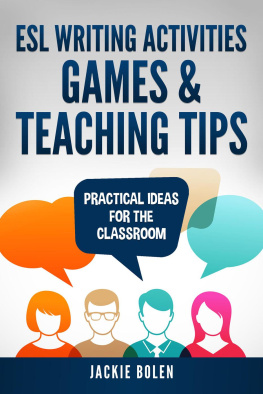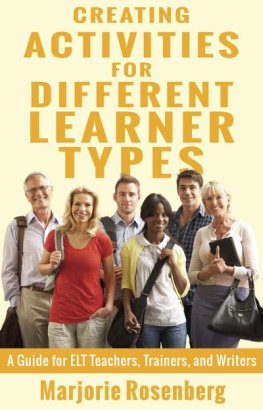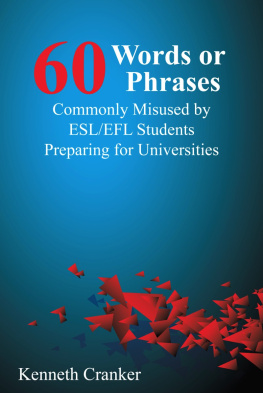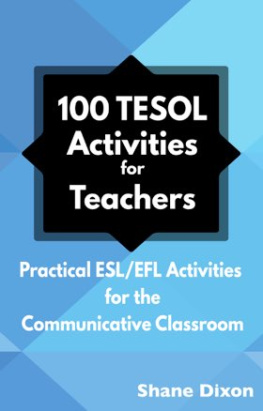Fifty Ways to Teach Listening
Janine Sepulveda
50 Ways to Teach Listening: Tips for ESL/EFL Teachers
Copyright 2012 by Janine Sepulveda; updated 2018
All rights reserved. No part of this publication may be reproduced, stored in or introduced into a retrieval system, or transmitted, in any form, or by any means (electronic, mechanical, photocopying, recording, or otherwise) without the prior written permission of the copyright owner. Dramatic works contained within this volume are intended only as reading material, and their inclusion does not imply the granting of performance licenses, which must be arranged through the author.
Edited by Dorothy E. Zemach. Cover design by DJ Rogers.
Published in the United States by Wayzgoose Press.
How To Use This Book
Most teachers use a textbook in class, which provides both instruction and practice but, often, not enough practice. Students need to practice again and again, and in different ways, not just to keep their interest but to both learn and remember.
This book gives you ideas to help your students practice listening in English. It can be used with any textbook, or without any textbook at all. It tells you how to adapt and extend exercises; it gives you games and warm-ups that can be added to any class; it gives you methods to practice both accuracy and fluency.
Not every idea will work for every student or for every class. Thats why there are fifty. We feel sure that many of the ideas presented here will bring you results if you try them sincerely and practice them regularly.
Here is a suggested method for using this book:
- Read through all of the fifty tips without stopping.
- Read through the tips again. Choose five or six that you think might work for your class. Decide when you will try them.
- Choose different types of ideas: Some that can be done independently, and some that work along with your textbook; some that focus on pronunciation, and some that focus on grammar or vocabulary.
- Each time you use one of the ways, make a note about how well it worked for you and why. Remember that most of the tips will work best if you use them several times (or even make them a habit). Dont try a tip only once and decide its no good for your students. Give the tips you try a few chances, at least.
- Every few weeks, read through the tips again, and choose some new ones. Discontinue using any methods that are not working for you.
Finally, consider trying some of the other books in our 50 Ways to Teach series. No one skill in English is really separate from the others. Speaking, listening, reading, writing, vocabulary, and grammar are all connected. Students who improve in one area will almost always improve in other areas too. The series includes special volumes for teaching young learners, teenagers, and for using technology in the classroom.
Introduction
This book is both for teachers who are new to ESL/EFL and teachers who are looking for more interactive activities for their English classes. This isnt an exploration of research and pedagogy, but a list of listening activities and tips for making activities more effective.
Not all these ways may work for your class exactly as written. However, it is always a good idea to look at an idea and think about how you could adapt it to fit your own context. When you read an idea, think about how you could change it to fit your students ages, levels, culture, and interests. Please feel free to adapt the activities in any way you like.
When considering trying the activities in this book, think about your course goals and objectives and which activities would be most useful in helping you reach them. Some of these activities can be modified to accompany or supplement a textbook; others provide opportunities to go beyond what your textbook might provide.
This book is divided into 5 categories:
- Activities that focus on building overall listening skills, including recognizing the main idea or listening for specific information;
- Activities that focus on building specific sub-skills, such as recognizing stress, intonation, contractions, reductions, tone, etc.;
- Activities for all ages that focus on listening but integrate other skills such as reading and speaking;
- Activities for older learners that focus on listening but integrate other skills such as reading and speaking;
- Tips for making listening activities more effective.
All linguistic skills are important in developing competence in a language. However, research indicates that, on average, native speakers of a language spend 40% of their time listening, 35% of their time speaking, 16% reading, and 9% writing. (See Burley-Allen, M. 1995. Listening: The forgotten skill. New York: John Wiley & Sons, Inc.) Therefore, it is essential that we dedicate time to helping our students develop good listening skills.
Use of authentic materials (texts used by fluent speakers of the language, not texts written for language learners) is also important. Many of these activities allow for the use of authentic texts, and you are encouraged to include them whenever possible. You can always simplify the task to fit your learners needs; for example, ask them to listen only for specific information only, and not to try to understand every word. Students who are used to hearing authentic language early on generally make more progress and feel more confident with English.
Where to Find Listening Materials
Here are some places you can look to find listening texts to use in class:
- Your textbook. If your textbook doesnt include the types of spoken texts you want, look at other textbooks that may be in your resource room.
- Your colleagues. Ask if they have extra books with CDs or cassettes you could use in your classes.
- Recordings you make. Record yourself alone, and ask some friends or colleagues to make some recordings with you, using a tape recorder, phone, computer, etc. Try to include a variety of voices: old, young, male, female, native, and non-native speakers.
- Online sites for ESL/EFL teachers and students; some of these have spoken texts and listening tasks for all ages and levels.
- Online sites for native speakers. Look for a variety of sources, such as news programs, music videos, radio broadcasts, advertisements, television programs, movie trailers, podcasts, and so on.
Start building your own library of listening materials, and soon you will have a wide variety of spoken texts to use in class and share with other teachers.
I
Big Picture Listening Skills
These activities focus primarily on students ability to understand spoken language and respond in various ways to demonstrate comprehension. There may be some simple writing or speaking involved, but those skills are not the main focus; basic listening comprehension is the primary focus. Some activities concentrate on comprehension of a main idea, while others concentrate on understanding specific words or phrases.











